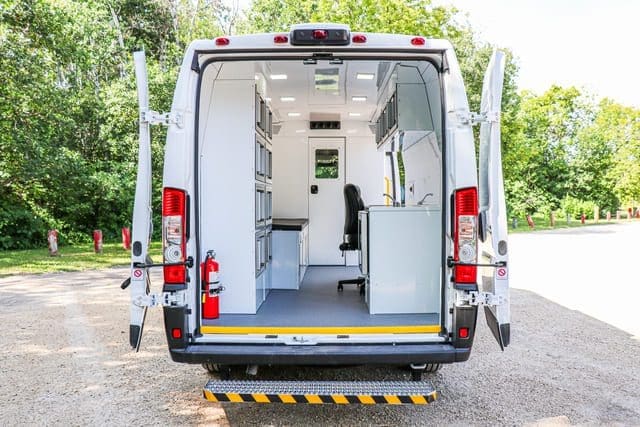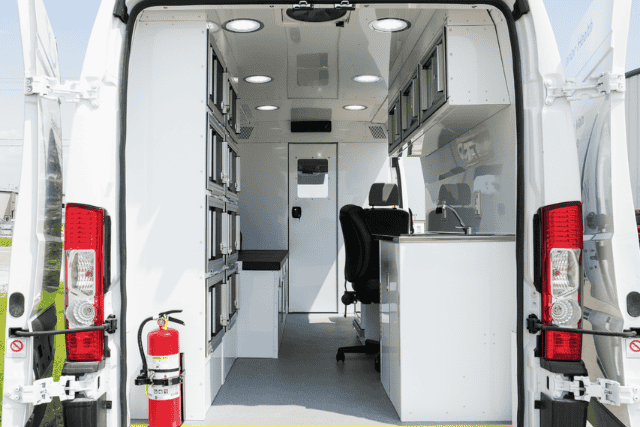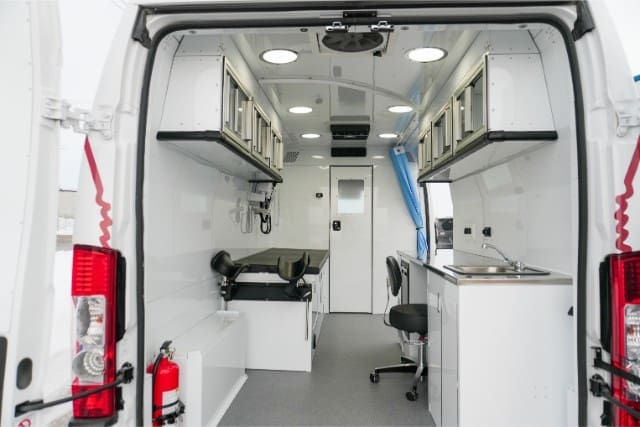Space constraints in mobile medical vans can lead to a crowded interior for the healthcare team and end up causing discomfort for patients during exams and treatments. For these reasons, your organization must learn how to use the van’s interior space to its fullest potential.
At AVAN Mobility, we believe patient care should never be an uncomfortable experience. That’s one of the reasons our engineering team puts such a tremendous amount of thought into all of the interior designs for our customers. This makes sure both your healthcare team and your patients never have to feel awkward during healthcare visits.
In this article, you’ll learn how to solve space constraints in mobile medical vans. We’ll talk about van materials and layouts and highlight what designs we’re coming up with to address this issue.
Why do mobile medical vans face space constraints?
Mobile medical vans are versatile vehicles that bring healthcare to people who face barriers to getting it. One of the barriers people face to receiving healthcare is living in remote and isolated communities. Mobile medical vans are short and nimble compared to something like a mobile medical RV or bus. That makes them perfect for navigating twisty roads and tricky terrain.
The reason why mobile medical vans face space constraints is because they have a shorter wheelbase. The wheelbase is the distance between the front and rear axles of a vehicle. Think of it like the backbone of a vehicle.
Because the wheelbase is shorter on mobile medical vans, that also means that the interior space will be a bit less. While space constraints in mobile medical vans might never even feel like an issue for your organization, it’s still worth talking about.
Tips for enhancing space efficiency in mobile medical vans
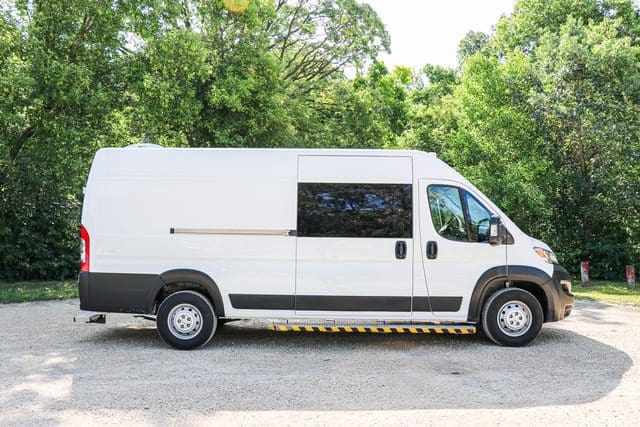
If you’re trying to figure out how you’ll have enough space inside your mobile medical van, keep reading to learn some important tips.
1. Define your organization’s purpose
Understanding the main goal of your mobile medical van sets the foundation for the interior design. Whether it’s for providing healthcare or primary care, allocating space for an exam bed is important. On the other hand, if the emphasis is on something like diagnostic services, the flexibility of equipment storage becomes just as important.
2. Consider the number of patients
Think about the number of people the mobile medical van needs to accommodate. If the typical transport is for more than two individuals, installing additional seats in the back might be necessary. While this choice consumes more space, it offers the advantage of flexibility. These seats can be easily removed, adapting the van’s interior based on specific needs.
Additional seats allow the van to serve a dual purpose—transporting multiple individuals when needed and creating extra space for medical examinations or treatments when the seats are removed.
3. Stick to aluminum
When it comes to materials for the interior of mobile medical vans, aluminum is the better choice. Why? Because it takes up less space.
Imagine this: A van packed with hospital equipment. If that equipment is surrounded by aluminum instead of bulkier materials like wood, you’ve just gained extra room to maneuver.
Tip: Don’t let your van feel like a crowded closet. Opt for aluminum to save space and keep things sleek.
4. Think long-term
Have you ever had a closet where things just didn’t fit right? That can happen in medical vans, too. When you build storage for specific items, think long-term. What if those items change size or become obsolete? Your space becomes wasted.
Tip: Plan for the future. Pay attention to standard sizing that can adapt to different needs. Your van should be flexible and ready for any alterations the future might throw at your organization. It’s easy to make the mistake of focusing on your organization’s immediate needs. It helps to shift your mindset to strategizing years down the road instead of only the present.
To do this, partner with professionals who know the best layouts for the different services you will provide. They’ll turn your van into a space-efficient, ergonomic haven for all users.
5. Use storage effectively
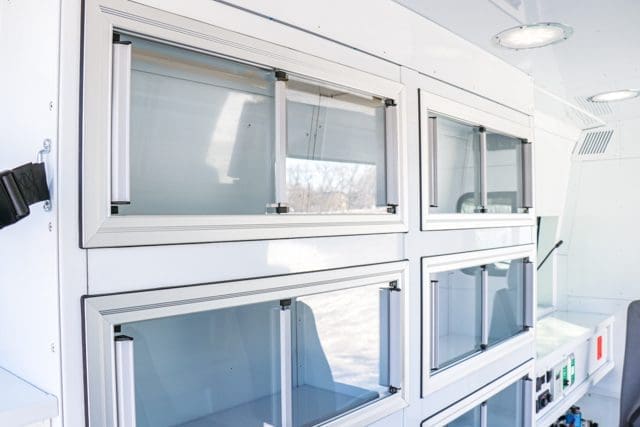
Each mobile medical van you look at might have different storage methods inside of them.
Floor-to-ceiling-cabinetry: The best cabinetry inside mobile medical vans is floor-to-ceiling cabinetry. This type of cabinetry makes use of the vertical space all the way from the van’s floor to the ceiling and ensures maximum storage capacity. It provides a secure and enclosed storage solution with a sleek and organized appearance.
This design reduces the need for horizontal space and enables you to make use of every inch of available space in the van. Floor-to-ceiling cabinetry gives your healthcare team quick access to stored items, and this is important during medical procedures or emergencies.
Wall-mounted storage: Wall-mounted storage units can hold important medical tools and supplies. This type of storage is beneficial because you keep the floor clear, making it easier for the healthcare team to move around and use what they need during medical tasks.
Custom-made cabinets: Consider aiming for cabinets that are specially designed for your medical van. Custom cabinets can be set up to fit all sorts of medical gear, medicines, and tools. This way, everything has its own spot, avoiding any mess and making the work smoother for your healthcare team.
Adjustable shelves: Shelves that can be changed around to suit different needs add a degree of flexibility to your setup. They allow you to rearrange things based on what the van is being used for. Whether it’s healthcare services or outreach programs, the shelves can be adapted to fit the plan.
Under-bed storage: Don’t forget the ample space under the exam bed. This area is perfect for storing lightweight items that are used by the healthcare team or patients. This keeps these items within easy reach while keeping the inside of the van neat and tidy.
Smart design choices for limited space in mobile medical vans
When it comes to making the most of space in mobile medical vans, the secret lies in tailoring designs to fit the unique needs of our customers. At AVAN Mobility, we understand that there’s no one-size-fits-all solution – it truly depends on what our customers are looking for.
Customer-centric design: Every customer has different needs, and that’s where we start. Understanding what our customers want is the cornerstone of our design process. We mold our designs to match your requirements.
Inclusive accessibility: In one of our future mobile clinic designs, we’re putting a special focus on making it even more accessible than it already is. Picture a side ramp and doors that make getting in with a wheelchair a breeze. It’s our way of ensuring that healthcare is inclusive and available to all.
In another exciting design, we’re introducing a swing door right in the middle of the van. This effectively turns the van into two separate rooms. Think of it as a waiting room right by the sliding door and, at the back, an area with an exam bed, a desk, a fridge, and a sink. It’s like having a mini-clinic on wheels, all within the space of the van.
Customized solutions: Our designs are not off-the-shelf solutions. We customize each mobile clinic to make it just right for the job.
What’s next?
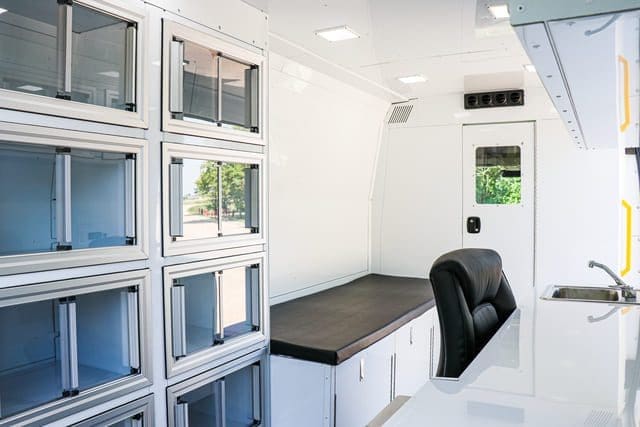
You made it to this article while looking for information on the space inside mobile medical vans.
After learning these 5 tips, we hope you will have a better idea of how to make the most of the space in these innovative vehicles.
In the world of mobile medical vans, where space is a premium, our designs at AVAN Mobility are all about efficiency without compromising on what our customers truly need. We believe that healthcare should be accessible, innovative, and tailored to fit the requirements of those we serve.
From here, we think you should check out our article on how to apply for mobile health grants. This article will give you a headstart on securing funding for your organization’s new mobile medical vehicle.
You’ll also find our article on the 10 steps to starting a mobile medical clinic beneficial. It’s a step-by-step guide that details some of the common things you need to know to get started.
If you have any questions, don’t hesitate to click the button below to talk to an expert.



